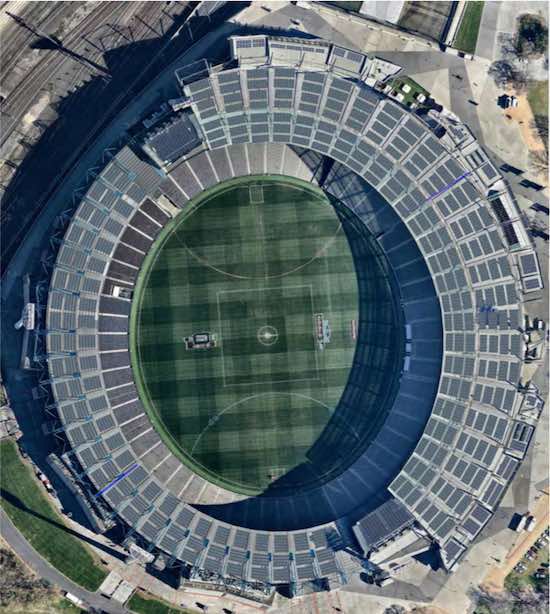

Businesses in Melbourne’s CBD could meet more than 12 per cent of their own electricity needs – and cut their collective power costs by more than $100 million – just by tapping the city’s true rooftop solar potential, a new study has found.
The research – published by the Australian Photovoltaic Institute (APVI) in conjunction with the University of NSW – has found that there is enough suitable rooftop space in the Melbourne local government area to install a total of 461MW of PV.
Like the Sydney-based study before it, the findings were produced using the APVI-UNSW Solar Potential Map – a tool, according to APVI chair Dr Renate Egan, “as accurate as going on the roof and taking measurements for a whole year.”
“We took into account local weather conditions, tilt of the roof, orientation and shading from nearby buildings and vegetation,” Dr Egan said this week.
The point of all this is to demonstrate the huge potential for distributed solar generation that exists in Australia’s major commercial centres – a market Australia’s rooftop solar boom has so far bypassed.
Currently there is only around 5MW of rooftop solar PV installed on Melbourne CBD buildings – around one-hundredth of the potential the mapping tool has uncovered.
If that solar potential was mined, the report estimates that around 38 per cent of the City’s total roof space could be fitted with close to 2 million solar panels, that could generate 548GWh a year – enough to power 112,000 average Victorian homes.
And a whole lot of money could be saved by city-based businesses.
“Electricity prices are set to rise with the wholesale futures prices skyrocketing, so the benefits to your hip pocket of generating your own power are increasingly obvious,” Egan says.
One business that is keenly aware of this, and which has also experienced the benefits of self generation first-hand, is NextDC.
The APVI-UNSW report was launched on Tuesday morning from the company’s Port Melbourne HQ, where a 400kW rooftop solar array was installed in December 2013.
Back then, the NextDC solar array claimed the title of first co-location data centre in the region to be powered directly by solar, and was also one of the largest privately funded rooftop solar systems in Australia. (See video of the NextDC system below, which was installed by local outfit Energy Matters.)
Much has changed since then, and commercial systems around this size are a dime a dozen. But not in the city.
NextDC – which is also a member of the Melbourne Renewable Energy Project consortium, that is contracted to buy one-third of the output of the 80MW Crowlands wind farm now under construction near Ararat – hopes to help change that.
“The entire economy relies heavily on electrical energy, which needs to be produced sustainably,” said NextDC COO Simon Cooper.
“Historically growth has been driven by heavy industry but data centres will be part of the future. That’s why we’re committed to ensuring more of our energy comes from renewable sources.”
Indeed, a deal sealed just this month by global computing giant, Microsoft, has helped to indicate what is possible in high density cities.
The US-based company signed an agreement with Sunseap Group to create the single-largest solar energy portfolio in Singapore to date, installing 60MW on hundreds of rooftops across the nation.
The deal is the largest rooftop solar project in Singapore and the first rooftop solar portfolio in the country focused on serving data-center energy consumption.
“Our cloud services are helping to power Singapore’s digital transformation, and today’s agreement will ensure that transformation is increasingly powered by clean energy,” said Kevin Wo, managing director, Microsoft Singapore.
So where could some of Melbourne’s 461MW of rooftop solar potential be realised? The table below, and the map at the top of the article show some of the city’s potential solar hot-spots, including the inner Melbourne suburbs of Fisherman’s Bend, Carlton, Port Melbourne and, of course, the CBD.
As well as factoring in suitable building rooftops, the study has modelled how some of Melbourne’s landmark buildings – including the MCG and Flinders Street Station – could go solar.
“We hope this information will allow property owners, policymakers and planners to recognise the financial benefits of installing solar as well as the potential emission reductions,” Dr Egan said.
To navigate the Solar Potential Map users can zoom in and isolate a particular property and the available solar energy, annual AC output, annual dollar saving and CO2 offset are all instantly calculated. Check it out here.
Sophie is editor of One Step Off The Grid and deputy editor of its sister site, Renew Economy. Sophie has been writing about clean energy for more than a decade.
This post was published on March 27, 2018 10:11 am
The pursuit of water and energy self-sufficiency on a small block in a densely-populated area…
A home battery that made its debut in Australia less than two years ago has…
ANU Senior researcher Dr Cheng Cheng reveals the electorates that could benefit most from renewables,…
Chinese solar manufacturer sets yet another efficiency world record, this time for its crystalline silicon-perovskite…
OpenSolar's Sophie Wright on the mission to streamline solar businesses so that more money and…
The federal electorate of Calare sits at the heart of Australia’s energy transition. Independent candidate…
View Comments
Just hang on to that idea. Government will need to ring their overlords in Washington, to check it is OK. Bet it won't be. The dark swamp creatures still have to be fed.
Not to mention all the warehouse, shopping centre roofs and carparks in the suburbs!